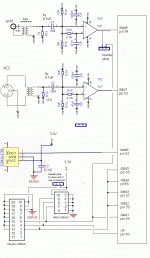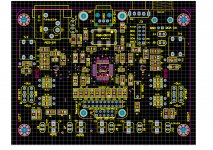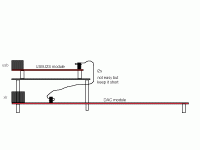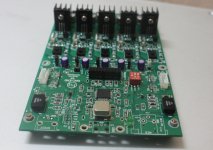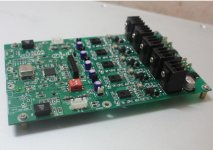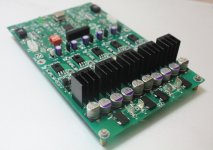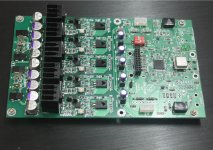SNR is not the main thing right, with dual or quad mono, many have claimed it sounds more analog - with a single 9018, it sounds very clear and detailed, but dry and uninvolving. I do not believe that the more analog sound simply comes from better implementation alone - cos almost all single 9018 sounds uninvolving
ES9018 in stereo or mono, is completely unchanged, nothing at all changes in the dac or analogue stages unless you want to adjust for lower voltage, or if your IV stage uses parts that cannot cope with the increased current.
all is identical except for the signal is all left or all right, its even sent the same signal in most dual mono dacs, the registers are simply set to identify as device 0 or device 1, depending on which one the dac will decode the left or right channel portion based on which Mono setting is used, there are 3. if there is more than 2 chips you need some sort of MCU and often a DSP, the Accuphase uses a completely custom digital filter and DSP on FPGA to run with the DSD signals interleaved and increase resolution I gather
It sounds like its not your experience, rather other peoples anecdotal reports or advertising.
myself i've been using it for ~3 years and have built myriad IV stages (have used transformers, passive Zfoil IV, NTD1 (highish voltage common gate mosfet), SEN and CEN jfet, several opamp based multiloop IVs) have 4 different USB-i2s convertors, the i2s fifo, 2 master clocks run synchronously and asynchronously and currently own 5 ess dacs... 2 buffalo II, 2 Ackodac AKD12P, and the 32S as well as a few built for others
it is much more sensitive to jitter than once thought, it is particularly sensitive to the quality of AVCC and DVCC supplies, i2s and clock quality and grounding is absolutely critical. Because it operates at quite high speed for a dac this puts demands on the layout and power supply decoupling, the Burson is a mess...
a well implemented single chip does not sound dry, or brittle, not in the slightest.
it really is ALL about the implementation with ESS, many designers get lazy with this dac because its such a turnkey solution with integrated digital filter, receiver and MUX. and produces sound acceptable to some with little effort
Last edited:
I agree qusp, as a lazy designer myself I'm far too lazy to spend time getting the implementation right on an ESS DAC. There are simpler and cheaper routes to involving sound.
hes got one thing right though, its absolutely not about increased SNR or THD, there are reasons to go dual mono with it, but thats not one of them, its hard enough to make -120dB THD+N count, i'm just saying it doesnt magically change the sound signature, because its just more of the same
yep, its not a magic bullet, ive heard a few shockers and the popular notion that an ESS dac is automatically great sounding is delusion. of course there are all manner of other solutions to good sound, i'm a tinkerer at heart and I do like the results with ESS, so it does suit me, I like the flexibility as well as the analogue performance when done right.
OT warning: i'm particularly interested in your experiments with DSPs and ARM, are you looking at going all the way and implementing a custom crossover and dac all in one FPGA+ARM solution? lazy? lol, just different priorities/obsessions. I was disappointed the ARDA stuff never made it into DIYERs hands, but maybe it saved me a whole world of new pain... I need to focus my efforts on other areas of my system for now; I have enough dacs
abraxalito said:I agree qusp, as a lazy designer myself I'm far too lazy to spend time getting the implementation right on an ESS DAC. There are simpler and cheaper routes to involving sound.
yep, its not a magic bullet, ive heard a few shockers and the popular notion that an ESS dac is automatically great sounding is delusion. of course there are all manner of other solutions to good sound, i'm a tinkerer at heart and I do like the results with ESS, so it does suit me, I like the flexibility as well as the analogue performance when done right.
OT warning: i'm particularly interested in your experiments with DSPs and ARM, are you looking at going all the way and implementing a custom crossover and dac all in one FPGA+ARM solution? lazy? lol, just different priorities/obsessions. I was disappointed the ARDA stuff never made it into DIYERs hands, but maybe it saved me a whole world of new pain... I need to focus my efforts on other areas of my system for now; I have enough dacs
Last edited:
As its so OT on this thread, I'll reply by PM. But feel free to start a thread to discuss these questions (which are definitely interesting), I'll contribute 🙂
cool, OK i'll do that, look forward to your PM, cant give an opening post enough thought today i've got work and GB responsibilities that need taking care of. definitely worthy subject matter though
back to your regularly scheduled program 😉
back to your regularly scheduled program 😉
Here the last input circuit to use with both the USB-I2S module and 3 other sources.
It is necessary a micontroller connected to the ES9018 to select the different inputs.
Here the last firmware available for 16LF877.
It is necessary a micontroller connected to the ES9018 to select the different inputs.
Here the last firmware available for 16LF877.
Attachments
Last edited:
ES9018 in stereo or mono, is completely unchanged, nothing at all changes in the dac or analogue stages unless you want to adjust for lower voltage, or if your IV stage uses parts that cannot cope with the increased current.
all is identical except for the signal is all left or all right, its even sent the same signal in most dual mono dacs, the registers are simply set to identify as device 0 or device 1, depending on which one the dac will decode the left or right channel portion based on which Mono setting is used, there are 3. if there is more than 2 chips you need some sort of MCU and often a DSP, the Accuphase uses a completely custom digital filter and DSP on FPGA to run with the DSD signals interleaved and increase resolution I gather
It sounds like its not your experience, rather other peoples anecdotal reports or advertising.
myself i've been using it for ~3 years and have built myriad IV stages (have used transformers, passive Zfoil IV, NTD1 (highish voltage common gate mosfet), SEN and CEN jfet, several opamp based multiloop IVs) have 4 different USB-i2s convertors, the i2s fifo, 2 master clocks run synchronously and asynchronously and currently own 5 ess dacs... 2 buffalo II, 2 Ackodac AKD12P, and the 32S as well as a few built for others
it is much more sensitive to jitter than once thought, it is particularly sensitive to the quality of AVCC and DVCC supplies, i2s and clock quality and grounding is absolutely critical. Because it operates at quite high speed for a dac this puts demands on the layout and power supply decoupling, the Burson is a mess...
a well implemented single chip does not sound dry, or brittle, not in the slightest.
it really is ALL about the implementation with ESS, many designers get lazy with this dac because its such a turnkey solution with integrated digital filter, receiver and MUX. and produces sound acceptable to some with little effort
Since you own buffalo ii, have you tried it in dual mono?
After many revisions Layout has been completed.
With the input
1. XMOS USB-I2S, USB Amonero
2. SPDF
3. Torx
4. AES
I arranged for the USB DAC is sent on the PCB, to ensure the shortest connection for I2S.
Please see it! Thanks
With the input
1. XMOS USB-I2S, USB Amonero
2. SPDF
3. Torx
4. AES
I arranged for the USB DAC is sent on the PCB, to ensure the shortest connection for I2S.
Please see it! Thanks
Attachments
Last weekend I did a listening test comparing my second AD1955 DAC output stage hybrid with the ES9018 DAC output stage with OPA627 + OPA2134.
The detail and definition seemed more good with ES9018 but the sound was too dry and not very musical.
I think the problem on the ES9018 DAC is the high feedback of op-amp so I decided to test it with a vacuum tube output stage.
The my choice is the Raleigh Audio Line Stage clone, a Differential parafeed line stage push-pull with a pair of CCS (constant current source) to isolate the power supply from the signal.
http://www.audiodesignguide.com/HiResolution/Raleighaudio1.jpg
Chapter 4
USB DAC 2 - Hi-Resolution System
Using a pair of ECC86 for each channel is possible to get a good result.
Here the first measurements of the output stage only.
To get 3Vrms on output it is necessary use 20 ohm as I/V instead of 10ohm.
Have You listen and compare to op amp output stage . Any better worse?
Have You listen and compare to op amp output stage . Any better worse?
Please see it:
ES9018 USB DAC - Hi-Resolution System
thanks
The test are finished, the new ES9018 DAC with the Amonero module is able to play 44,88,96,192,384KHz, DSD file and SACD iso images.
The firmware remap the DAC to share the same input pin for PCM and DSD without hardware changes.
We will integrate the Amonero module to get a very short I2S wire.
See news on:
ES9018 USB DAC - Hi-Resolution System
The firmware remap the DAC to share the same input pin for PCM and DSD without hardware changes.
We will integrate the Amonero module to get a very short I2S wire.
See news on:
ES9018 USB DAC - Hi-Resolution System
How much is the cost of DAC-END R? Are you guys selling it as a kit? or assembled, ready to use? Can you you give us details?
Thanks,
Fred
Thanks,
Fred
The ES9018 DAC will be an assembled module without output stage and it will cost about 300$, Amonero USB-I2S/DSD module cost 97$
There are 2 options for the output stage, the vaccum tube stage is very simple and it can be assembled on air without pcb.
After the first definitive test on the last pcb we think to start a list of pre-order to reduce the cost of production.
There are 2 options for the output stage, the vaccum tube stage is very simple and it can be assembled on air without pcb.
After the first definitive test on the last pcb we think to start a list of pre-order to reduce the cost of production.
Do you think the price would go down a bit if theres a lot of interest, for the introductory price of this DAC? Can you give us the dimension of the DAC board? How about the controller module? I think that's a cool feature to include on this DAC. How much do you think would it cost?
Sorry for the asking to much question.
Thanks,
Fred
Sorry for the asking to much question.
Thanks,
Fred
Do you think the price would go down a bit if theres a lot of interest, for the introductory price of this DAC? Can you give us the dimension of the DAC board? How about the controller module? I think that's a cool feature to include on this DAC. How much do you think would it cost?
Sorry for the asking to much question.
Thanks,
Fred
DAC board size: 11 cm X 20Cm.
Thanks
Buffalo is similar product. As a designer hi knows good an bad points of his dac and deferences , if any. Unprofessional it would be if i ask to judge Buffalo , maybe i ask wrong question . In that case i would like to ask what deferent from Buffalo.
The DAC module develop with Quanghao use separated fast shunt for all the power supply of ES9018 and for the oscillator.
It have 4 input: spdif RCA, spdif toslink optical, AES/EBU XLR professional standard and USB to play PCM and DSD files.
Here some more info about:
ES9018 USB DAC - Hi-Resolution System
A controller module is integrated to display on LCD Volume level, input type and more info about the configuration.
All the controller mode functions can be changed with a simple remore control.
It have 4 input: spdif RCA, spdif toslink optical, AES/EBU XLR professional standard and USB to play PCM and DSD files.
Here some more info about:
ES9018 USB DAC - Hi-Resolution System
A controller module is integrated to display on LCD Volume level, input type and more info about the configuration.
All the controller mode functions can be changed with a simple remore control.
- Status
- Not open for further replies.
- Home
- Source & Line
- Digital Source
- DAC-END R (ES9018)
